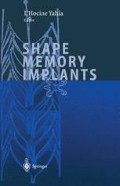Abstract
Among the different applications of NiTi materials in medicine, force delivery systems in orthodontics are among the most promising. To move teeth orthodontically, forces of a specific magnitude are necessary. Too little force and tooth movement is slow or there is no movement at all. Too much force and there might be undesired side effects such as pain, anchorage loss, and root resorption. With nventional elastic materials, force degradation due to movement of the teeth or time-related degradation is always present and requires frequent reactivations of the force delivery systems. The advent of superelastic NiTi alloys promised to almost eliminate the force degradation problem and to design force delivery systems with precisely tuned force magnitudes. Within the scope of this chapter we look into a number of aspects related to the use of NiTi materials in orthodontics.
Access this chapter
Tax calculation will be finalised at checkout
Purchases are for personal use only
Preview
Unable to display preview. Download preview PDF.
References
Andreasen GF, Brady PR (1972) A use hypothesis for 55 Nitinol wire for orthodontics. Angle Orthod 42:172–177
Andreasen GF, Barret RD (1973) An evaluation of cobalt-substituted Nitinol wire in orthodontics. Am J Orthod 63:462–470
Andreasen GF, Morrow R (1978) Laboratory and clinical analyses of nitinol wire. Am J Orthod 73:142–151
Kusy RP, Greenberg AR (1982) Comparison of the elastic properties of nickel-titanium and beta titanium arch wires. Am J Orthod 82:199–205
O’Brien WJ (1989) Dental materials: properties and selection. Quintessence, Chicago, p 386
Burstone CJ (1981) Variable-modulus orthodontics. Am J Orthod 80:1–16
Burstone CJ (1985) Chinese Ni-Ti wire: a new orthodontic alloy. Am J Orthod 87:445–452
Miura F, Mogi M, Ohura Y, Hamanaka H (1986) The super-elastic property of the Japanese NiTi alloy wire for use in orthodontics. Am J Orthod Dentofac Orthod 90:1–10
Ibe D, Segner D (1998) Superelastic materials displaying different force levels within one archwire. Fortschr Kieferorthop 59:29–38
American National Standards Institute/American Dental Association ASC MD156 Specification 32 (1977) J Journal of the American dental association 95:1169
Ødegaard J, Meling T, Meling E, Holte K, Segner D (1995) An evaluation of the formulas for bending with respect to their use in estimating force levels in orthodontic appliances. A theoretical and in vitro study. Kieferorthop Mitt 9:73–88
Segner D, Ibe D (1995) Properties of superelastic wires and their relevance to orthodontic treatment. Eur J Orthod 17:395–402
Segner D (1995) Kraftniveau pseudoelastischer Nivellierungsdrähte in Abhängigkeit vom Interbracketabstand. Fortschr Kieferorthop 56:34–40
Plietsch R, Bourauel C, Drescher D, Nellen B (1994) Ein rechnergestützter Biegemeßplatz zur Bestimmung der Elastizitätsparameter hochflexibler orthodontischer Drähte. Fortschr Kieferorthop 55:84–95
Reitan K (1951) The initial tissue reaction incident to orthodontic tooth movement as related to the influence of function. Acta Odontol Scand (Suppl 6)
Bench RW, Gugin CF, Hilgers JJ (1977,1978) Bioprogressive therapy. J Clin Orthod 11,12
Ibe DM, Segner D (1998) Superelastic materials displaying different force levels within one archwire. J Orofac Orthop 59:29–38
Burstone CJ, Qin B, Morton JY (1985) Chinese NiTi wire - a new orthodontic alloy. Am J Orthod Dentofac Orthop 87:445–452
Segner D, Bonowski S (1999) Variationen in der Kraftentfaltung des Nackenzug-Headgears. Kieferorthop 13:135–144
Owman-Moll P, Kurol J, Lundgren D (1995) Effects of increased force magnitudes on tooth movement and root resorption. Eur J Orthod 17:347
Rygh P, Brudvik P (1993) Root resorption and new wire qualities. Eur J Orthod 15:343
Maltha JC, Dijkman GEHM (1996) Discontinuous forces cause less extensive root resorption than continuous forces. Eur J Orthod 18:420
Editor information
Editors and Affiliations
Rights and permissions
Copyright information
© 2000 Springer-Verlag Berlin Heidelberg
About this chapter
Cite this chapter
Siegner, D., Ibe, D. (2000). Clinical Application of Shape-Memory Alloys in Orthodontics. In: Yahia, L. (eds) Shape Memory Implants. Springer, Berlin, Heidelberg. https://doi.org/10.1007/978-3-642-59768-8_15
Download citation
DOI: https://doi.org/10.1007/978-3-642-59768-8_15
Publisher Name: Springer, Berlin, Heidelberg
Print ISBN: 978-3-642-64118-3
Online ISBN: 978-3-642-59768-8
eBook Packages: Springer Book Archive

